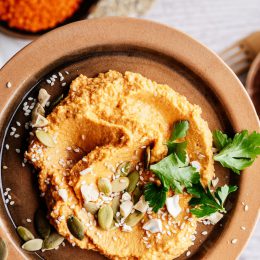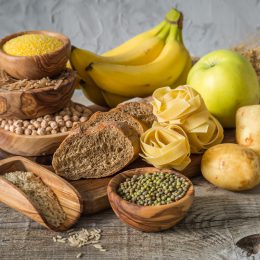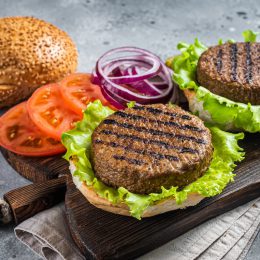Should You Ditch Low-Fat Foods for Good?
Low-fat foods are staples on grocery store shelves. But are they healthier choices? Here’s what you need to know to decide.

The low-fat diet craze has mostly faded from headlines. But the idea that fat is bad lingers. And food companies aren’t helping. They continue to churn out low-fat versions of nearly everything.
We get it. Low-fat foods are appealing — they’re often much lower in calories than their full-fat counterparts. That’s because fat is “calorie dense” — it has more than twice as many calories per gram than protein and carbs. So reducing fat in your diet or in a food product is an easy way to cut calories.
Whether or not this leads to weight loss is less clear. Which brings us back to the original question — should you choose low-fat foods?
Whole foods that are naturally low in fat, like fruit, vegetables, whole grains, and beans are always a good idea. But low-fat versions of foods that are typically high in fat are more questionable. Here’s what you need to know.
Healthy eating and fitness go together! SilverSneakers classes and events are happening daily at participating gyms, online through SilverSneakers LIVE, and at community centers near you. Activate your free online account to get started.
Overcoming a Fear of Fat
Fat is an important part of our diets, and we don’t need to avoid it entirely.
“Healthy fat can certainly fit into a healthy lifestyle,” says registered dietitian Toby Amidor, R.D. She’s an award-winning nutrition expert and author of Diabetes Create Your Plate Meal Prep Cookbook.
But it’s important to know the difference between saturated fats and unsaturated fats.
“It’s the saturated fat that has been linked to an increased risk of heart disease,” explains Amidor.
Saturated fats are:
- Found mostly in foods that come from animals
- Solid at room temperature, like butter and lard
Unsaturated fats are the “good fats.”
“Unsaturated fats are anti-inflammatory. They help to lower cholesterol, and improve heart health,” explains Sandra Arévalo, M.P.H., R.D.N. She is the director of community health and wellness at Montefiore Nyack Hospital and spokesperson for the Academy of Nutrition and Dietetics.
Unsaturated fats are:
- Found in plant-based oil, fatty fish, nuts, seeds, and avocados
- Liquid at room temperature
Understanding the difference between good and bad fats is the first step in deciding if a low-fat food is right for you. To help, take a look at the pros and cons of certain low-fat foods:
Recommended reading: Want to Eat Healthier? Here’s What to Do First
Packaged Low-Fat Snacks and Sweets
Pros: If you’re trying to lose weight or lower your fat and cholesterol intake, low fat snacks can help.
Cons: “If you eat more than you normally would because of the low-fat label, that defeats the purpose,” says Arévalo. “You should stick to the same portion sizes if you really want to see the benefits.”
This is a pitfall for many low-fat foods, she says. Many people incorrectly believe that they have a green light to eat more of something that is low in fat or calories. In the end, they often end up eating more calories than if they had stuck to a proper portion size, she explains.
You can see examples of this today. One popular treat maker, for example, makes a low-fat, low-calorie ice cream. The company prominently displays the calories per pint (2 cups) on their container. The message they’re sending is that you can (and should) eat the whole pint in one sitting.
Not only does this derail sensible portion control, cautions Arévalo, you may end up eating more calories than you would have had you chosen traditional ice cream. A 2/3-cup serving of regular vanilla ice cream has about 180 calories. But a whole pint of the maker’s low-fat vanilla has 290 calories.
The takeaway: Whether you choose low-fat or regular versions of snack foods, it’s still important to eat sensible portion sizes.
The other important question to ask when considering prepackaged snacks is: What is the fat being replaced with?
In many packaged snack foods, fat is important to achieving a certain texture and taste. “Sometimes manufacturers sacrifice fat content, but they can’t sacrifice flavor,” says Arévalo.
Often, more sugar is added. But too much added sugar is just as bad for our health as too much saturated fat. The Dietary Guidelines for Americans recommend limiting both to less than 10 percent of your total daily calories.
Low-fat versions of snacks may also have more sodium, another nutrient that most of eat too much of.
“To choose the best foods, it is important to look at the nutrition facts panel,” says Arévalo.
Compare the calories, saturated fat, sodium and added sugar in low-fat versus regular versions of a product to make the best choice for you.
Low-Fat Dairy
Pros: Dairy foods like milk, yogurt, and cheese can be high in saturated fat. As such, the Dietary Guidelines for Americans recommend low- or non-fat dairy.
“Choosing low or nonfat milk verses whole milk only reduces the saturated fat and calories,” says Amidor. “There are really no other major differences nutritionally, so this can be a good swap.”
For example, a cup of whole milk has 150 calories and 5 grams of saturated fat. Nonfat milk has just 80 calories and no saturated fat. But they have the same amount of carbs, protein, vitamins, and minerals like calcium.
Cons: If you like the flavor and body of full-fat dairy, Amidor says it can be part of a healthy diet. It’s just a matter of balancing it with other saturated fats.
While you should limit saturated fat, there’s no need to get rid of it entirely, she explains. The Dietary Guidelines for Americans recommend getting less than 10 percent of your calories from saturated fat. That’s about 22 grams for someone eating 2,000 calories a day.
Some newer studies also suggest that saturated fat in dairy may not be as bad for heart health as we once thought. For example, one study from 2018 found that dairy fat was not linked to death from heart disease in people over 65. It even seemed to lower their risk of death from stroke. The findings were published in the American Journal of Clinical Nutrition.
Margarine
Margarine has been around as a low-fat alternative to butter for more than a century. It surpassed butter sales in the 1950s. In the decades that followed, Americans were eating about twice as much margarine as butter.
But sales started dropping in the 1990s. This is when researchers discovered that the trans-fats from the partially hydrogenated oils in most margarine products are actually much worse for our health than saturated fats.
Subscribe to our newsletter
It's quick and easy. You could be one of the 13 million people who are eligible.
Already a member? Click to discover our 15,000+ participating locations.
Follow Us
Pros: Margarines these days no longer have trans-fat, thanks to a ban on partially hydrogenated oils.
Cons: Margarines may have less saturated fat than butter, but they usually have just as much total fat and calories. So whichever you choose to use, it’s best to use sparingly.
Again, Arévalo recommends looking at the nutrition facts panel to compare the calories, total fat and types of fat in different products. She also likes to look at the ingredients and prefers products with a shorter ingredient list.
Tip: Amidor also recommends “rethinking your smear” and trying alternatives to butter. “You can always smear some soft avocado, hummus, or peanut butter on your toast instead. Or switch between the light buttery spreads and other healthy fats,” she says.
Recommended reading: The 5 Healthiest High-Fat Foods, According to Dietitians
Low-Fat Salad Dressing
Pros: There are no pros! Low-fat or fat-free dressings are tempting, however Arévalo and Amidor agree there are better ways to flavor your salads.
Cons: These types of salad dressings can easily turn a bowl of leafy greens into a calorie bomb. And like other processed foods, they often have a lot more added sugar and salt than their full-fat versions.
Full-fat dressing has another benefit — it can actually help you get more nutrients out of your salad, according to researchers at Purdue University.
Here’s why: The leafy greens and other vegetables in salads are high in fat-soluble vitamins. These vitamins need to be eaten with fat to be fully absorbed during digestion.
(That said, the fat does not have to come from dressing. Cheese, nuts, and seeds in a salad will also provide fat. Or, if you’re having a salad with an entrée that has fat, that will aid nutrient absorption as well.)
Tips: Vinaigrettes are the best option for salad dressings. They’re made with heart-healthy oils like olive and canola oil.
“I always prefer to make my own salad dressings,” says Arévalo. “There’s nothing more flavorful than olive oil, vinegar, and lemon or lime juice.”
Whatever dressing you choose, use it sparingly. Full-fat dressings are very calorie dense, so you should stick to a portion size of no more than two tablespoons.
“Dress your salad, don’t drown it,” says Arévalo.
Activate Your FREE SilverSneakers Online Account
Get hundreds of free SilverSneakers On-Demand videos and stay in touch with us by creating your free online account. You don’t have to be a SilverSneakers member to get on-demand workout videos, health and fitness tips from SilverSneakers, and more.
SilverSneakers members can go to thousands of nationwide gyms and fitness locations, plus take SilverSneakers LIVE online classes led by specially trained instructors and designed for all fitness levels and abilities – at no additional cost. If you have a Medicare Advantage plan, it may include SilverSneakers. Check your eligibility here.
Already a member? Get your SilverSneakers member ID, search for locations near you, and all the health and wellness resources you need by logging in to your online member account here.





